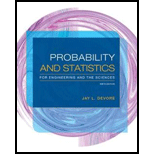
Concept explainers
Develop the appropriate large sample test procedure.
Check whether the plant densities are equal for region 1 and region 2.
Answer to Problem 94SE
The data do not suggest the sufficient result that the plant densities are equal for region 1 and region 2.
Explanation of Solution
Given info:
The data represents the samples taken from the randomly located square sampling quadrate having the area of 1 m2.
Here,
Calculation:
Large sample test procedure:
The estimate of
Here
The estimate of
Here
Then it is assumed that
The variance of
The pooled estimate of
Test statistic:
Here, the sample size is large. That is,
Test procedure:
The aim of the problem is to test the hypotheses that the plant densities are equal for region 1 and region 2.
Assume that the alternative hypothesis as
The mean of the region1 is
The test hypotheses are,
Null hypothesis:
That is, the plant density of region 1 is equal to the density of region 2.
Alternative hypothesis:
That is, the plant density of region 1 is different from the density of region 2.
The value of the
The value of the
The test statistic value is obtained below:
Substitute
Thus, the test statistic value is –5.33.
From Appendix, “Table A.3 Standard Normal Curves”, the standard normal value of –3.40 at 5% level of significance is 0.000.
So, the
The P-value is obtained as given below:
Thus, the P-value is 0.
Decision rule based on P-value approach:
Rejection region for a right-tailed test:
If
If
Conclusion:
Here, the P-value is less than the level of significance.
That is,
Thus, the decision is “reject the null hypothesis”.
Thus, it can be concluded that there is no enough evidence to infer that the plant densities are equal for region 1 and region 2.
Want to see more full solutions like this?
Chapter 9 Solutions
Bundle: Probability and Statistics for Engineering and the Sciences, 9th + WebAssign Printed Access Card for Devore's Probability and Statistics for ... and the Sciences, 9th Edition, Single-Term
- solve the question based on hw 1, 1.41arrow_forwardT1.4: Let ẞ(G) be the minimum size of a vertex cover, a(G) be the maximum size of an independent set and m(G) = |E(G)|. (i) Prove that if G is triangle free (no induced K3) then m(G) ≤ a(G)B(G). Hints - The neighborhood of a vertex in a triangle free graph must be independent; all edges have at least one end in a vertex cover. (ii) Show that all graphs of order n ≥ 3 and size m> [n2/4] contain a triangle. Hints - you may need to use either elementary calculus or the arithmetic-geometric mean inequality.arrow_forwardWe consider the one-period model studied in class as an example. Namely, we assumethat the current stock price is S0 = 10. At time T, the stock has either moved up toSt = 12 (with probability p = 0.6) or down towards St = 8 (with probability 1−p = 0.4).We consider a call option on this stock with maturity T and strike price K = 10. Theinterest rate on the money market is zero.As in class, we assume that you, as a customer, are willing to buy the call option on100 shares of stock for $120. The investor, who sold you the option, can adopt one of thefollowing strategies: Strategy 1: (seen in class) Buy 50 shares of stock and borrow $380. Strategy 2: Buy 55 shares of stock and borrow $430. Strategy 3: Buy 60 shares of stock and borrow $480. Strategy 4: Buy 40 shares of stock and borrow $280.(a) For each of strategies 2-4, describe the value of the investor’s portfolio at time 0,and at time T for each possible movement of the stock.(b) For each of strategies 2-4, does the investor have…arrow_forward
- Negate the following compound statement using De Morgans's laws.arrow_forwardNegate the following compound statement using De Morgans's laws.arrow_forwardQuestion 6: Negate the following compound statements, using De Morgan's laws. A) If Alberta was under water entirely then there should be no fossil of mammals.arrow_forward
- Negate the following compound statement using De Morgans's laws.arrow_forwardCharacterize (with proof) all connected graphs that contain no even cycles in terms oftheir blocks.arrow_forwardLet G be a connected graph that does not have P4 or C3 as an induced subgraph (i.e.,G is P4, C3 free). Prove that G is a complete bipartite grapharrow_forward
 Glencoe Algebra 1, Student Edition, 9780079039897...AlgebraISBN:9780079039897Author:CarterPublisher:McGraw Hill
Glencoe Algebra 1, Student Edition, 9780079039897...AlgebraISBN:9780079039897Author:CarterPublisher:McGraw Hill
